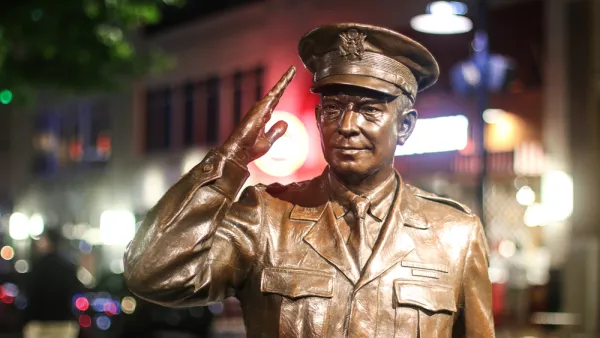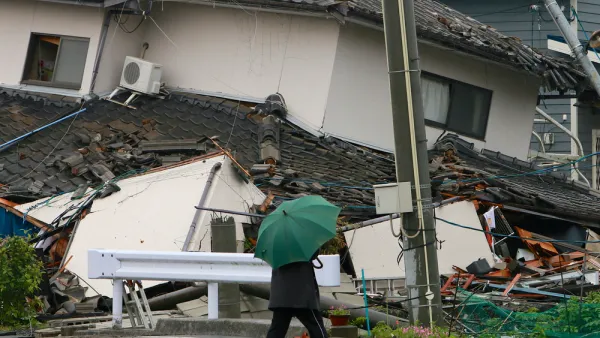In light of the recent controversy surrounding the Eisenhower Memorial in Washington DC, and observations from a recent trip to Japan, Christopher Hawthorne pens an opinion piece on memorials - the "eternally fraught corner of design practice.
In reflecting on his recent trip to Japan and future efforts to memorialize the 19,000 who perished as a result of last year's earthquake and tsunami, Hawthorne ruminates on recent memorializing processes in the United States - at the World Trade Center, to Martin Luther King Jr., and to President Eisenhower - and sees an opportunity, and need, to rethink the processes and products of memorial design.
For Hawthorne, a visit to a giant red fish-oil tank, mangled by the tsunami and sitting in a median in Ishinomaki, Japan, that he describes as an "odd piece of apocalyptic detritus", provides a potent symbol of the disaster.
It reflecting on "how overpriced and underwhelming so many traditional memorials have turned out to be in recent years," Hawthorne finds inspiration from his Japanese experience. "By contrast, the mangled red can in Ishinomaki eludes both bombast and easy readings. The way it manages to suggest two very different scales simultaneously - the quotidian scale of the supermarket shelf and the stunning strength of the tsunami - gives it some Pop art shadings and makes it even more artistically meaningful than, say, the twisted steel beams from the World Trade Center that will go on display at the Sept. 11 museum."
Also of note, on the subject of memorials, is a report by Philip Kennicott in The Washington Post on yesterday's congressional hearing on Gehry's Eisenhower Memorial design. At the hearing, Susan Eisenhower, granddaughter to the President, and representing the family, called for scrapping the current design, which she comapred to, "Communist-era decorations that honored 'Marx, Engels and Lenin.' She likened large columns that will be used to hang the metal scrims to 'missile silos,' mentioned Ho Chi Minh and Mao, and argued that Holocaust survivors were affronted by the similarity of the tapestries to the fences of Adolf Hitler's death camps."
According to Kennicott, "It's not clear whether Congress will reopen the [memorial design] process, especially given that eight of the Memorial Commission's 12 members serve in Congress. And while there has been growing momentum for revisiting the Gehry design among traditionalists and culture warriors, concern about the design hasn't coalesced into a coherent critique."
FULL STORY: Critic's Notebook: Rethinking memorials in aftermath of Japan tsunami

Analysis: Cybertruck Fatality Rate Far Exceeds That of Ford Pinto
The Tesla Cybertruck was recalled seven times last year.

National Parks Layoffs Will Cause Communities to Lose Billions
Thousands of essential park workers were laid off this week, just before the busy spring break season.

Retro-silient?: America’s First “Eco-burb,” The Woodlands Turns 50
A master-planned community north of Houston offers lessons on green infrastructure and resilient design, but falls short of its founder’s lofty affordability and walkability goals.

Test News Post 1
This is a summary

Analysis: Cybertruck Fatality Rate Far Exceeds That of Ford Pinto
The Tesla Cybertruck was recalled seven times last year.

Test News Headline 46
Test for the image on the front page.
Urban Design for Planners 1: Software Tools
This six-course series explores essential urban design concepts using open source software and equips planners with the tools they need to participate fully in the urban design process.
Planning for Universal Design
Learn the tools for implementing Universal Design in planning regulations.
EMC Planning Group, Inc.
Planetizen
Planetizen
Mpact (formerly Rail~Volution)
Great Falls Development Authority, Inc.
HUDs Office of Policy Development and Research
NYU Wagner Graduate School of Public Service




























